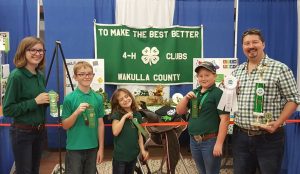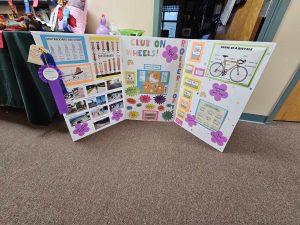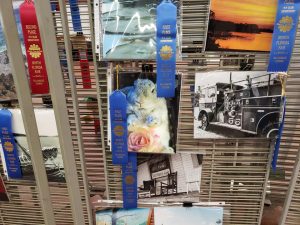Fairs have been part of the 4-H youth development experience since 1902. The origins of what we have come to know as a fair can be historically documented as early as 500 BC. The earliest fairs were community celebrations to recognize religious feast days, celebrations of the harvest, and festive occasions when traveling entertainers visited towns and villages. In some communities, fairs were a source of revenue for churches.
In modern times, fairs have come to be associated with midway rides and creative fair vendor food offerings. However, for 4-H members county, regional, and state fairs are an important part of the 4-H club year. Youth members prepare exhibit entries that may include crafts, photos, baked goods, art, and models. Fairs in the United States have agricultural roots. The first fairs were organized at the county level by local agricultural societies. These fairs included competitions that featured the best livestock specimens. In the United States, the county agricultural fair tradition dates back to 1811. 4-H members may show poultry or livestock. Youth may compete in a skills or knowledge-based competition or skill-a-thon. Today’s fairs showcase agriculture with livestock competitions and exhibits. Modern fairs have added components that help connect the community to other agricultural products and may featured baked goods, canned items, honey, and more.
4-H Project Learning and the Local Fair
Positive youth development is at the heart of the 4-H experience. Fair participation can serve as a hands-on way to learn and apply life skills beyond the club setting. Youth may be earning blue ribbons while they also learning important life skills and becoming engaged members of their local community.
4-H members can enter projects in the fair in multiple categories. For example, a poultry project can be documented with a tabletop exhibit that illustrates how the project was conducted. The bird may be entered as an exhibit in the agricultural department. Photos of the bird may be entered into the photography category. Youth can design a flyer to sell eggs and enter it into the graphic design category. Other possible fair entries can be products produced as part of the 4-H learn by doing experience in clubs or summer camps. Projects can be documented through photos, graphic designs, or exhibits and all of this work can become one or more fair entries.
Preparing fair entries can be part of the 4-H year and can also serve as ways to document youth learning and, at the same time, recognize achievement. Youth can enter artwork, poetry, crafts, constructed models, collections, and baked goods. Fair exhibit entries may do double duty for county and state events. For example, a photo or graphic design entry may also be used for competition in a county showcase or entered in the state contest.
Preparing to enter an exhibit, compete in a skill-a-thon, or to show a project animal at the fair can provide youth with a time-limited, concrete goal to achieve. For example, in Wakulla 4-H, club leaders kick off the club year in September with an introduction to the North Florida Fair and the ways to participate so that youth can opt to start the membership year with a fair experience. After the North Florida Fair concludes in November, club leaders encourage the youth to set their sights on preparing a presentation or entry for county showcase and state contests.
Fairs and the 4-H Club Year
From the state fair to county and regional fairs, there is a fair participation opportunity available for every 4-H member. The Florida State Fair is held in Tampa each February. This fair includes agricultural science skill-a-thons, the Florida 4-H Food Challenge, and other agricultural contests.
There are a wide variety of opportunities to attend and participate in a local fair throughout the Florida Panhandle and Big Bend region. Some fairs limit entries to one county or multiple counties while other fairs allow any 4-H member to enter exhibits or competitions. Some fairs may also have a dual FFA component. It is not uncommon for Future Farmers of American (FFA) and 4-H members to be in the same agricultural shows together.
The Washington County Youth Fair spans late February into early March. The Santa Rosa County Fair is held annually in April. The Northwest Florida Fair is held in Fort Walton Beach in September. The Walton County Fair is also held in September in DeFuniak Springs. The Central Panhandle Fair is held annually October in Bay County. The Pensacola Interstate Fair is also held in October in Escambia County. While the North Florida Fair in Tallahassee closes out the fair calendar year in November, the 4-H club year has only just started!
For more information about 4-H and how to become involved with clubs, camps, and fairs, find your local Extension office in any Florida county.
The Institute of Food and Agricultural Sciences (IFAS) is an Equal Opportunity Institution authorized to provide research, educational information, and other services only to individuals and institutions that function with non-discrimination with respect to race, creed, color, religion, age, disability, sex, sexual orientation, marital status, national origin, political opinions, or affiliations. U.S. Department of Agriculture, Cooperative Extension Service, University of Florida, IFAS, Florida A&M University Cooperative Extension Program, and Boards of County Commissioners Cooperating.
Resources
Fairs Provide Life Skills for 4-H Youth
Motivation for and Developmental Benefits of Youth Participation in County 4-H Fairs: A Pilot Study
Why Are Fairs So Important to 4-H?
- All About Tabletop Exhibits for the North Florida Fair - September 10, 2024
- Beyond the Blue Ribbon: Make the Most of the 4-H Experience with Your Local Fair - July 5, 2024
- Tips to Help Youth and Families Handle Back-to-School Stress - July 28, 2023



